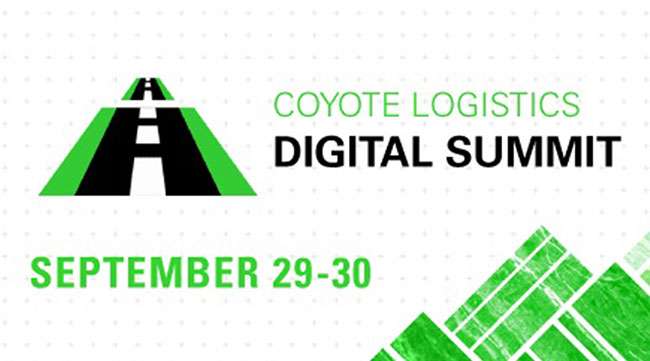Staff Reporter
What Q4 and Beyond Have in Store for Transportation

[Stay on top of transportation news: Get TTNews in your inbox.]
The outlook for transportation and logistics in the fourth quarter focuses on the lingering effects of the coronavirus pandemic as well as the impending shopping season.
Panelists on Sept. 29 shared their insights as part of a series of discussions in the Coyote Logistics Digital Summit.
“When you think about the last year, even going back further than that, the start and stop of what’s been delivered to us continues to impact our freight markets, but also, markets in general,” said Rick Blasgen, adviser for the Council of Supply Chain Management Professionals (CSCMP). “Disruptions have been varied.”

Blasgen
Blasgen noted the supply chain was not built for the global economy shutting down and opening back up. But that is what happened during the onset of the pandemic. He noted such a dynamic has led to volatile transportation markets and high freight prices.
“We’re in the supply chain decade,” Blasgen said. “Who knows what will come out of this. But I’m sure there will be a lot of things we’ll look back on and wonder how we got there. We’ll look back on it and say we implemented some pretty important tools and processes going forward.”
Blasgen retired as presdient and CEO of CSCMP in March after being appointed to the position in 2005.
IHS Markit Director Paul Bingham echoed concerns over how economies globally have faced shutdowns and then unanticipated and strong rebounds in consumer spending. He noted those metrics have revealed inadequacies in the supply chain to meet the still elevated demand for goods.

Bingham
“We saw some recovery in North America and Western Europe headed into the summer,” Bingham said. “But then we got hit globally with this delta variant wave, where we’ve seen some retrenchment in terms of economic performance. We’ve had labor issues that have come, not just from the direct health impacts of the pandemic, but also the impacts on the productivity of workers and their willingness to take certain types of jobs.”
Bingham added those have been pervasive and challenging issues that have impacted performance and also have resulted in price increases. But there are reasons for optimism going into the fourth quarter and beyond.
“Some of this demand is transitory, kind of like inflation,” Bingham said. “Eventually, consumers start to spend more on services when they feel more safe and secure in the economy and their state is not being shut down. Then you’ll start to see some substitution away from goods consumption, which gives the entire system a chance to catch up.”

For some, truck driving is a passion, and the best are America's Road Team Captains. ABF driver Nate McCarty, former America's Road Team Captain, and Elisabeth Barna, COO and executive vice president for American Trucking Associations, join us. Hear a snippet above, and get the full program by going to RoadSigns.TTNews.com.
Bingham also has seen the impact of some of the capacity additions from carriers starting to play out. But, he warns, there are exceptions to those trends. The import containerized goods sector still is facing record-high rates, backlogs and a shortage of chassis.
“We’ve got a long way to go, probably past the fourth quarter, to see some real recovery in rates starting to come down and the capacity additions really starting,” Bingham said. “But before that, for the broader economy, in terms of freight domestically, we do see some softening already, the early stage of that. And we would anticipate that will pick up as we get into next year. But it’s not going to be overnight.”
Blasgen agreed with the assessment but warned there still are some unknowns such as shifts in monetary policy and how fiscal stimulus will impact consumer spending.
“There are some logistics wild cards like natural disasters, of course; trade policy shifts, which we really haven’t talked much about as of late; reshoring; and then labor markets,” Blasgen said. “Are we stuck with tight labor markets across the board here for the foreseeable future? What has to happen in order to bring some relief to that?”
The Consumer Brand Association, CSCMP, Coyote, Vector and numerous consumer packaged goods companies formed a task force early in the pandemic to create contactless delivery standards. The original purpose was to prevent the spread of the virus, but benefits in the approach means such practices may last well beyond Q4.

Chu
“When we think about the continued surge in consumer demand, it’s created a lot of congestion at warehouses for trucks,” Vector CEO Will Chu said. “You combine that with a labor shortage where there aren’t as many security guards processing drivers, combine that with the need for social distancing, there’s an opportunity to really digitize the workflows around pickup and delivery to solve all of those issues.”
Chu added that shipping information being electronic and digital has facilitated a more visible and efficient process for truckers and the facilities they are delivering to or picking up shipments from.
“Companies have had to invest at a pace that they had not anticipated prior to the pandemic,” Bingham said. “That’s led to a much more accelerated investment in technology solutions to help improve productivity.”
Coyote Logistics is a subsidiary of UPS Inc., which ranks No. 1 on the Transport Topics Top 100 list of the largest for-hire carriers in North America.
Want more news? Listen to today's daily briefing below or go here for more info:




